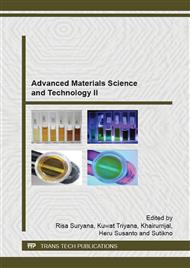p.109
p.114
p.119
p.123
p.127
p.131
p.135
p.140
p.147
Development of Geopolymer from Fly Ash and Metallurgical Slag
Abstract:
Geopolymers, which areinorganic polymers consisting largely of three-dimensional Al-Si-O networkformed by reactions between aluminosilicate solids and concentrated alkalisolutions, are gaining recognition as environmentally friendly engineeringmaterials. As a replacement for ordinary Portland cement (OPC), geopolymerconsumes much less energy to produce, and may be synthesized from various solidinorganic waste materials. This work describes the synthesis of geopolymerswhich combines two waste materials as aluminosilicate precursors: an ASTM ClassC coal fly ash from the Paiton powerplant, and Fe-rich metallurgical slag fromKratakau Steel. To study the effects of the reactant mixture composition, asimplex centroid experiment is undertaken with fly ash and slag as its majorcomponents, and level of addition of sodium silicate as the independentvariable. The highest slag to ash mass ratio is set at 50%. The solidaluminosilicates and sodium silicate are mixed with 10 M KOH solution at a massratio of 2.8. The mixture is processed in a planetary mixer to form a smoothpaste, which is then cast into specimens for the measurement of compressivestrength in a universal uniaxial load tester after a 1-week period of curing atroom temperature. The measured compressive strengths of all geopolymer pastesamples are lower than that of OPC, anddecreases with increasing slag proportion. Addition of Sodium silicateincreases the strength due to decreased porosity. Despite the highertheoretical reactivity of the slag compared to the Paiton fly ash, estimatedfrom their degrees of network depolymerization, the addition of slag reducesthe geopolymer mortar compressive strength. It is hypothesized that therelatively coarse size of the slag particles offsets its higher reactivity.
Info:
Periodical:
Pages:
127-130
Citation:
Online since:
August 2015
Authors:
Keywords:
Price:
Сopyright:
© 2015 Trans Tech Publications Ltd. All Rights Reserved
Share:
Citation:


